After a bumpy road through the arid mountains of Dhofar, we arrive at a dry wadi (river valley) where resin seeps like blood from a gnarled tree. Ahmed, an incense farmer, carefully uses his knife to cut the paper log and collects the aromatic gum, which dries to form crystals the color of spun sugar.
For millennia, frankincense has been harvested in this region of Oman and traded in remote places such as Mesopotamia, Rome and India.
The ancient Egyptians used it for mummification, the magicians brought it as one of their gifts and it has played a role in religious rituals around the world. Hence its nickname “food for the gods.”
I’m traveling with my husband Mark and two sons, Zac and Archie, ages 12 and 10, to Dhofar, also known as the Incense Coast, in the far south of the country.
“At its peak, trade was worth more than gold,” says our guide Mussallem, dressed in a long dishdasha, the tunic worn by Omani men, and a tasseled headscarf called a masaar. “Before oil, it was our main export.”
Dune delight: Kate Eshelby and her family travel to the Dhofar region of Oman, where they visit the world’s largest sand desert (file image)
Later, we continue descending through deep canyons, passing dragon trees that seem to miraculously bloom on the rocks and desert roses with Barbie pink flowers. Mussallem explains: ‘When I was a child, there were no roads here and none of us had shoes. We were still nomads and lived in caves.
His family (he has eight children) only settled in a village in 1997, a testament to how recently Oman has transformed. “Sultan Qaboos bin Said built the country from nothing,” he continues.
Sultan Qaboos was the longest-serving leader in Oman and ruled until his death in 2020, after coming to power with British support in a bloodless coup in 1970, which overthrew his father. He is revered for transforming the country from an isolated and underdeveloped state to a modern and stable nation.
Qaboos played a decisive role in the development of the country we see today: infrastructure, modernization, education, but also low-rise buildings. Unlike other Middle Eastern countries, there are no skyscrapers or jewels.
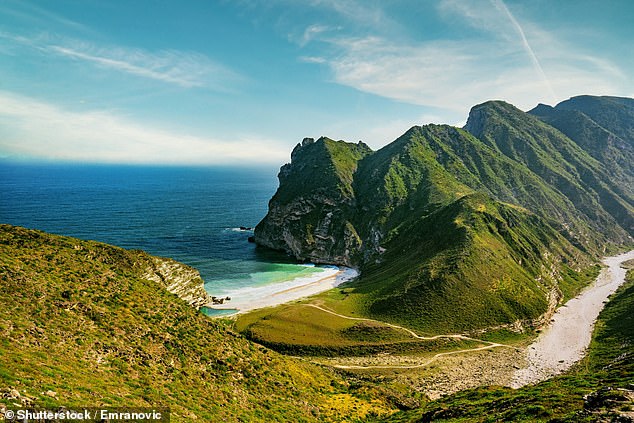
Oman is home to some bright green places, Kate points out. Pictured is Al Mughsail Salalah.
Arriving at Al Fazayah Beach, we wade into the warm waters as Mussallem lays out hand-woven rugs and cushions under a rocky ledge, preparing a picnic of falafels, chicken samosas, mangoes and salads.
Oman is home to some of the driest territories on Earth, but Dhofar, during the monsoon months of June to September, becomes a striking oasis of bright green.
Moisture-laden winds from the Indian Ocean arrive, creating the surreal vision of cows grazing alongside camels and waterfalls of water cascading from the mountains to the beaches.
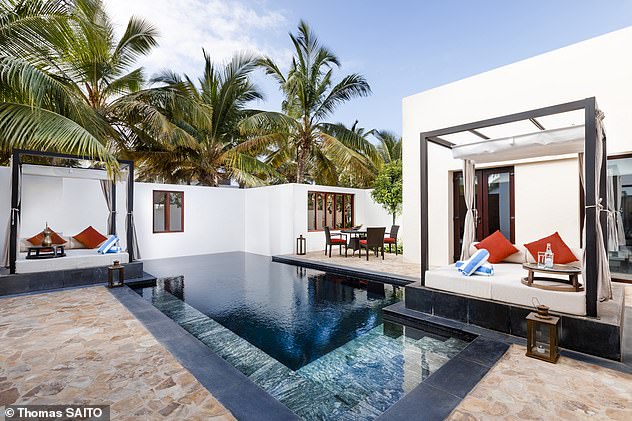
In Salalah, Kate stays in a garden villa with a private pool (seen here) at Al Baleed Resort by Anantara.
Its almost tropical microclimate means that coconut trees, bananas and papayas grow all year round. However, it is not just the landscape that sets Dhofar apart, the culture and food are also different from the rest of the country.
The monsoons not only work their magic on land, but also affect the waters, causing upwellings of nutrients along the Dhofar coast, adding incredible richness to the Arabian Sea. There are days when we kayak through clumps of phosphorescence and our paddles light them up, so they glow neon like glow-in-the-dark stars. On other occasions, we snorkel among hawksbill turtles, which swarm to feed on the colorful corals.
Our trip starts in the capital, Muscat, and from here we fly to Salalah, the main town of Dhofar, and stay at the Al Baleed Resort by Anantara, a 20-minute drive away, right on the beach.
We are welcomed with small cups of incense infusion and then we settle into one of the villas with a garden and private pool.
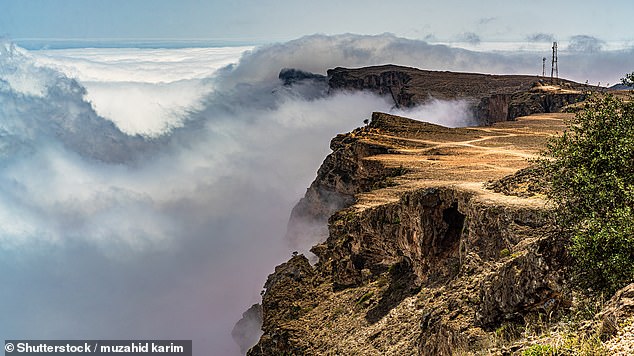
Jabal Samhan Nature Reserve (pictured) is one of the last remaining sanctuaries for the critically endangered Arabian leopard, Kate reveals.
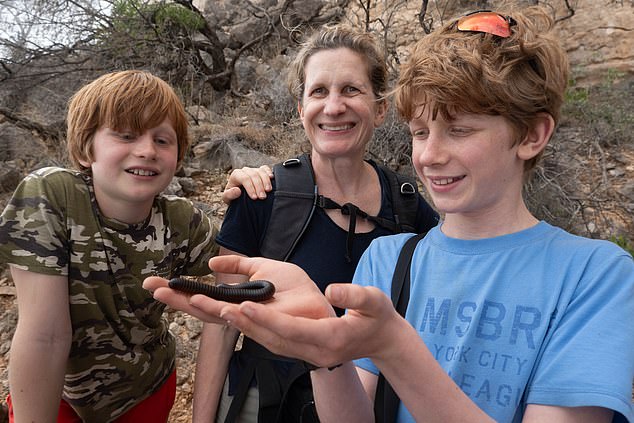
Kate with her sons Zac and Archie at Samhan Nature Reserve, while Zac examines a millipede
I eat breakfast while the dolphins swim and one early afternoon I indulge in an invigorating massage (with frankincense oil, naturally) at the spa.
Nearby stand the fortified ruins of the ancient city of Sumhuram, which once stood guard over one of the Arabian Peninsula’s major incense ports. I imagine ships coming and going at the height of trade in 3 BC. C., carrying the precious incense from east to west and returning with silk, spices and ivory. Meanwhile, camel caravans traveled with him, north through the desert to the legendary city of Petra.
“According to legend, the Queen of Sheba came here to get incense for King Solomon,” Mussallem says proudly.
Frankincense comes from the Boswellia sacra tree, which grows wild in the desert areas of the Arabian Peninsula and the Horn of Africa, although the best quality is believed to come from Oman, with its distinctive fragrance. Over time, the ancient trade routes collapsed due to better shipping and synthetic incense. However, in Oman the tradition lives on.
Frankincense remains a cornerstone of everyday life, used to perfume homes and clothing and as a symbol of ever-present Omani hospitality. Enter any home and you will be greeted by scented smoke spiraling from an incense burner.
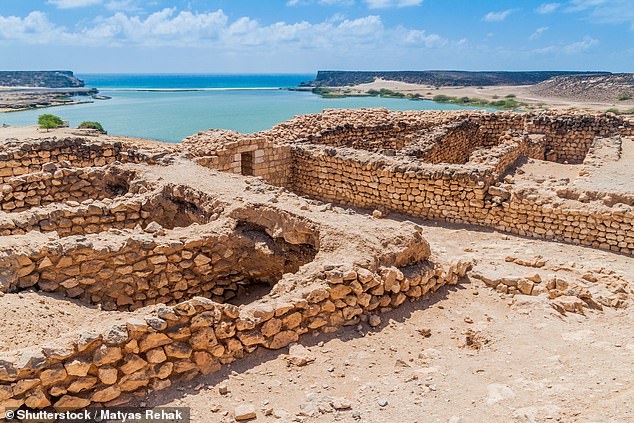
Above, the fortified ruins of the ancient city of Sumhuram that once guarded one of the Arabian Peninsula’s main incense ports. “I imagine ships coming and going at the height of trade in 3 BC, carrying precious incense from east to west and returning with silk, spices and ivory,” Kate writes.
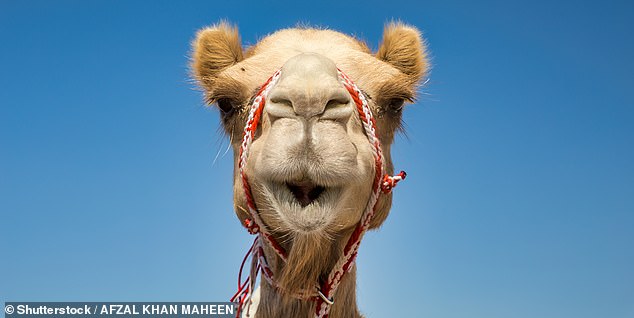
Kate explains that Dhofar has a unique climate: “Moisture-laden winds from the Indian Ocean blow in, creating the surreal vision of cows grazing alongside camels and waterfalls of water cascading from the mountains to the beaches” (archive image)
On another day, we ventured into the 4,500 square kilometers of wilderness of the Jabal Samhan Nature Reserve, one of the last remaining sanctuaries for the critically endangered Arabian leopards, high in the Dhofar Mountains. We see the ever-changing landscape of Oman, with acacias, more reminiscent of Africa, and elephant baobabs, the size of trucks.
As we begin walking, climbing into this mystical realm of shifting mists and sheer cliffs, we are joined by Khalid, an expert who has been working with these elusive animals for 18 years.
As we wander along a rocky ledge, he shares a recent photograph on his phone: of a female leopard and her cub, captured in this very spot with one of the wildlife camera traps. Below is a wide view of peaks emerging from the clouds like archipelagos.
The last leg of our journey takes us to the Empty Quarter of Oman, the largest sand desert in the world, north of Dhofar. For this wild camping adventure, we will be guided by Mussallem’s son, Mohammed.
Along the way, we will stop at Wadi Dawkah, where the luxury perfume house Amouage has created a refuge for incense trees because these plants are considered near threatened.
That night we camp in a natural rock amphitheater, and our children eagerly climb to find their own nests carved into the limestone while dinner cooks over the fire.
The next day, we continue and suddenly the imposing dunes appear before us, the color of ripe apricots and as soft as peeled clay. We set up camp and, slides in hand, run barefoot down the sandy spine of one, pausing to gaze at an expansive ocean of winding ridges before heading back down.
Later, our kids love seeing geodes, sparkling with crystals inside, sitting in the sand like soccer balls. While incense may still hold its place in Oman, the country’s gold value now lies in its wild beauty, varied landscape and rich biodiversity.

